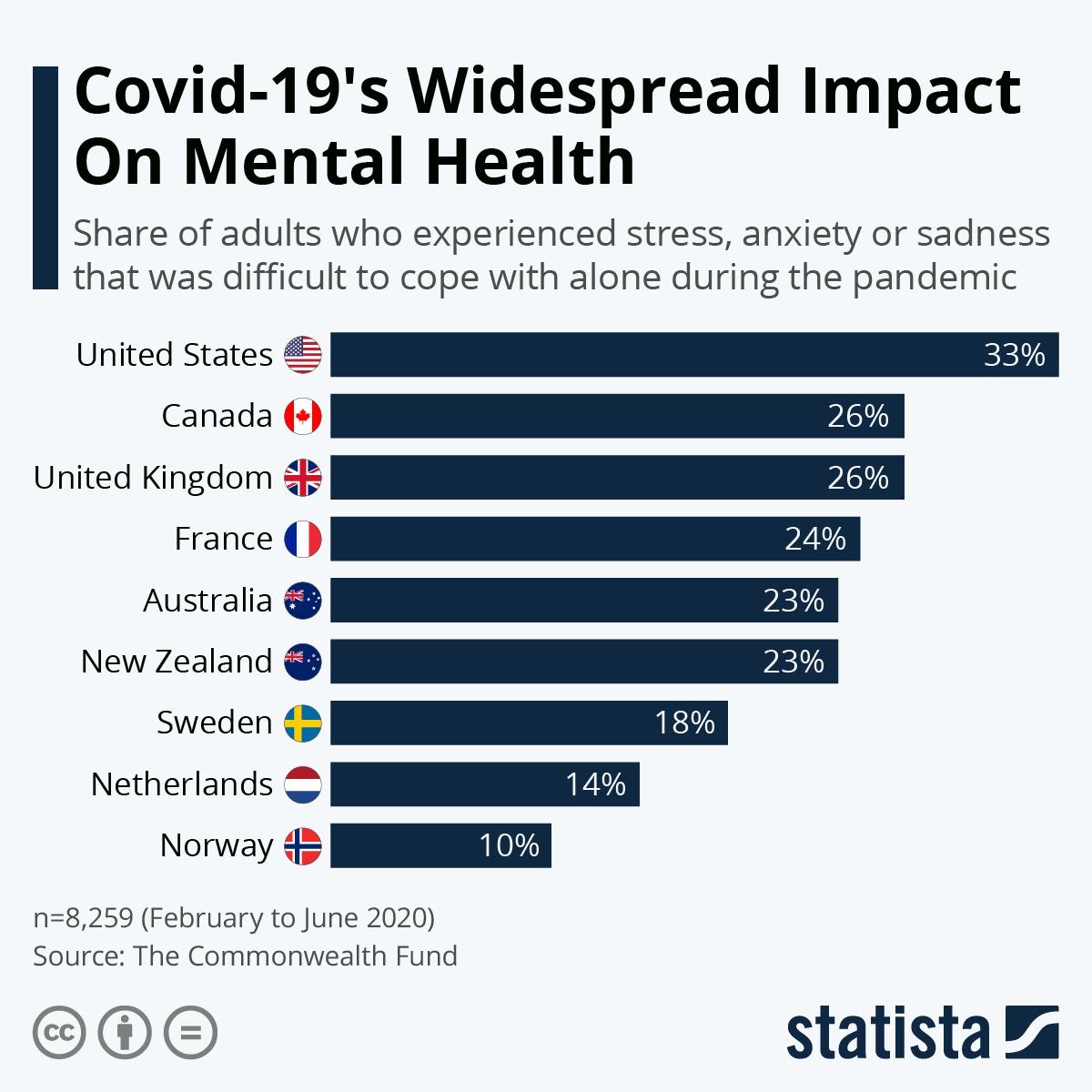Coronavirus Effects on Mental Health
-By Sania Patel

Mental health is defined as a person’s condition concerning their psychological and emotional wellbeing. Typically, mental health is affected by biological factors, life experiences, and genetic history; however, the COVID-19 pandemic introduced an entirely new cause of mental health - one that would affect about four in ten adults in the United States alone. Ultimately, the COVID-19 pandemic led to isolation due to quarantine, political unrest, and societal divisions. Amid the pandemic, social riots and protests were rampant due to the murder of George Floyd. The COVID-19 pandemic led to a loss of security, connections, and trust; the setting created uncharacteristically high aggression, depression, and anxiety rates.
On January 20, 2020, the CDC confirmed the arrival of the first case of COVID-19 in the U.S. Since then, there has been an exponential rise in mental health issues, most points highlighting suicidal ideation. A KFF Health Tracking Poll from July 2020 reported that 92 percent of adults had negative impacts on their mental health and wellbeing due to worry and stress over the virus. Not only are adults facing increasing mental health issues, but there is also a stark increase with children. During the pandemic, children ages five to twelve reported elevated symptoms of depression, and the KFF Health Tracking Poll recorded a 41 percent increase in children with mental health issues and symptoms.
Under the umbrella of isolation, one of the main side effects of the pandemic was quarantine. Quarantine caused pronounced isolation between the nuclear and extended family, and it strained relationships, as loved ones were separated at home or in the hospital. The idea of quarantine and the coronavirus caused great anxiety, and many people, especially urban dwellers, who were forced to lock themselves in their homes. Quarantine led to greater fear, agitation, and aggression, as routines and relationships were disrupted. The inability to control the given situation led people to be helpless, and, in turn, these factors compiled and caused mental health issues to breed.
Another side effect of the pandemic that further caused isolation was social and political unrest. During the pandemic, people become categorized into specific sects based on their political views and social standpoints. The divisions created acted as a domain for violence and racism to thrive; protests and riots rose to meet the demand of the indignant people. Extremists began to emerge, creating foundations for solid viewpoints. As discrimination increased, many past friendships and relationships were destroyed, contributing to improved mental health issues. Due to the pandemic, people began to find themselves physically and emotionally isolated, which compiled to form negative mental spaces.
Mental illnesses are increasingly prevalent in the U.S; however, many people who face these issues cannot receive medical care. Many people lack the savings or insurance plans to cover the costs of therapy and other treatments. According to Mental Health America, “Both adults and youth in the U.S. continue to lack adequate insurance coverage. 11.1 percent of Americans with a mental illness are uninsured. There was a 0.3 percent increase from last year’s dataset, the second year in a row that this indicator increased since the passage of the Affordable Care Act (ACA). 8.1 percent of children had private insurance that did not cover mental health services, totaling 950,000 youth.”
On the other hand, many people refuse to receive mental health care due to personal preference. In the United States, 34% of adults point to their lack of confidence in the mental health system as the number one reason for not seeking professional help. Another 22 percent of adults refused to seek help because of stigma or fear of not wanting people to know.
Many individuals faced worsening mental health; however, due to situations or preferences, they refused to seek professional help. As the COVID-19 restrictions diminished in the U.S, people began to face the adverse effects of forced isolation. According to an American Psychological Association poll of nearly 1,800 psychologists, 74 percent said they saw more patients with anxiety disorders than before the pandemic, and 60 percent said they were seeing more patients with depressive disorders. Nearly 30 percent said they were seeing more patients overall.
Healthy ways to cope with the pandemic are emerging in response to the high demand for therapy and other forms of mental treatment. The CDC offers the following advice, “Taking care of yourself can better equip you to take care of others. During social distancing, it is crucial to stay connected with your friends and family. Helping others cope with stress through phone calls or video chats can help you and your loved ones feel less lonely or isolated.” The CDC also provides a list of resources and social support services for those feeling affected by the pandemic.
Overall, the COVID-19 pandemic affected people’s mental health through isolation, political controversy, and social conflicts. The pandemic challenged people’s ability to adapt to uncharted territory and adapt to challenging situations. In the U.S, people’s mental health degraded through the challenges and fears that arose from the spread of the virus. The importance of mental health-related treatments was realized through the pandemic, and the number of supporters swelled. Treating mental health issues must become more efficient and convenient, as the number of stresses has surged in the past few years.